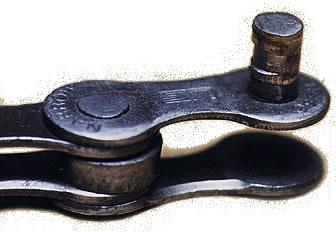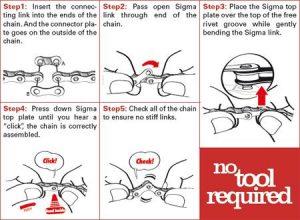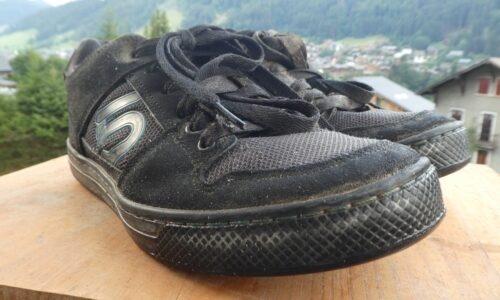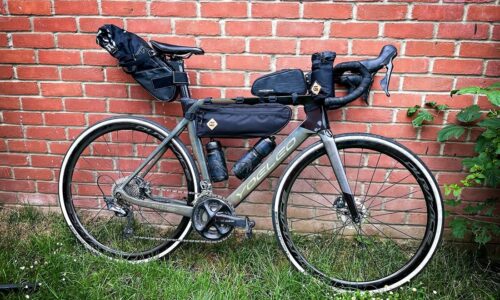
8/1/2013 TEST COMPLETE
| TAYA | DECA-101 |
| WEBSITE | http://www.tayachain.com/ |
| MODEL TESTED | DECA-101 10-speed (HG) chain featuring SIGMA CONNECTOR |
| MSRP | check on Amazon |
| SIZE | 1/2” x 5/64” |
| FINISH TESTED | Silver/Silver |
| FINISH AVAILABLE | Silver/Black, Ti-Gold, GST |
| CLAIMS | Chain life up to 5,000km (3,107 miles) |
| RATING | 4.5/5.0 |
| FEATURES |
|
| SOURCE | Bike Shops, Online Retailers |
| PROVIDED BY | Sample from company |
| ALSO AVAILABLE |
|
| HOT! |
|
| NOT! |
|
Taya states the “DECA DHT 1 series, 101 chain life is up to 5,000 KM (which is 3,107 miles). To test this, TAYA was gracious enough to send my team several of these chains. Here is the usage and life report.

Taya DECA 101 – 10 speed chain
A chain is a chain? Not so. The Taya DECA 10 is a High Quality, Highly Durable, Ultra-Long wearing chain. I was able to get a little over 3,500 hard use miles out of the chain. Taya hardens the pins so that they are very resistant to wear and, coupled with a high quality chain lube (such as ProLink), the chain will perform at a high level pf performance for thousands of miles. This chain was ridden hard in all different conditions, wet, dry, sandy, etc.
WHEN IS A CHAIN WORN OUT?
Most people believe that a chain is worn out when it is ‘stretched’ to the point of starting to skip on the rear-

cassette. Chains do not really ‘stretch’ by the side plates being pulled on by repeated pedaling, but, in fact, the bushings and inner plates are wearing themselves into the pins and that sum of these individual small wear marks adds up to an elongated chain. When the chain get too long, it starts skipping on the cassette and will start to damage the chain rings and cassette.
BUT, there is a second factor that no one else has discussed other than here by this author. And this does not become apparent until you get some HIGH mileage on a chain. This second factor is the wearing-out of the side plates. As the chain shifts between sprockets, the individual teeth come into contact with the side plates as the chain is moving up and down between gears. That is the sound you hear when shifting.
This constant shifting takes its toll on the plates and starts to abrade them away. After many miles, shifting will become slower and slower, very sluggish and hesitant to move easily into a different gear on the cassette.
Even though the pins of this chain are heat treated to the point of wearing very little, the side plates were eventually worn to the point of noticeably slower and slower shifting. Even though the Part Tool CC-2 Chain Checker showed less than 80% wear, the side plates were work to the point of unacceptable shifting performance. See picture below.

To summarize, this is a very high quality and long-life chain worthy of your consideration. It shifts fast and wears slowly and, if taken care of, will provide months and months of enjoyable riding.
NOTE: To get maximum life out of your chain, use a high quality lubricant such as ProLink chain lube before each ride.
| |||||||||||||||||||||||||||||||||||||||||||||||||||||||||||||||||
| ||||||||||||||||||||||||||||||||||||||||||||||||||
| ||||||||||||||||||||||||||||||||||||||||||
| ||||||||||||||||||||||||||||
| |||||||||||||||||||||||||||
| |||||||||||||||||||||||||||||||||||||||||||||||||||||||||||||||||||||||||||||||||||||||||||||||||||||||||||||||||||||||||||||||||||||||||||||||||||||||||||||||||
* 2,500 miles, I changed Rear Derailleur, Removed and replaced master link
** 3,500 miles catastrophic failure of master link. Due to the pins being part of the links, the chain held together for the 10 miles back to the start of the ride.
SUMMARY:
Chain did indeed exceed wear, shifting and toughness expectations. Pins are very hard and tough making the chain very resistant to “stretching”, but, this shifted the wear to the outer side plates. Master Link concept is a great idea but needs to be rethought since mechanics can easily (a) install it incorrectly so it isn’t ‘locked’ on, (b) over bending which can induce metal fatigue causing it to snap.

| TEST RIDER OBSERVATIONS |
| RIDER #1 |
By far, the best lube used was PROLINK (amazon, official web). PROLINK kept the chains clean and didn’t pick up any unnecessary dirt or grit, which would have caused excessive and unnecessary chain wear. I am using a new PARK CC-2 chain checker tool and will be using to check the %wear indication listed below. My CC-2 has been certified as accurate by Park Tool. When I initially installed the chain and then checked the chain for %wear, I was surprised to see that I could not fit the CC-2’s pins into the chain. This means that the initial chain measured less than 0%. For this test I am estimating -10% ‘wear’. The only other chains I have used are Shimano. 90% of the Shimano chains I have used are Ultegra, the other 10% have been Dura-Ace. The best initial check with Shimano chains have shown 20% wear out of the box. The worst was a new Dura-Ace chain with a 50% wear indicated. I have spoken to the Shimano engineers and have been told that with proper lubrication (over lubricating, then wiping off excess), you can get upwards of 2,500 miles out of a Shimano chain. Using this technique, I typically get 2,500-2,800 miles out of a Shimano chain. My riding conditions are usually the same so I attribute this difference to the initial wear indication. With this said, and with the same daily clean and lube, I am looking forward to seeing how many miles I get out of this new Taya DECA-101 chain. Installation: For this chain, not the typical Shimano-type push-pin installation. The detailed instructions are  actually on the inside of the box which most people throw right in the trash. I recommend that Taya Chain add a graphic on the front of the box (in bright-bold letters) stating the detailed instructions are on the inside of the box AND that the Sigma Connectors are located in a sealed area at the bottom of the box … so only throw the box away after your chain is installed correctly. One of my testers installed the chains so he will provide his write up below discussing this topic. Noticeably absent from the Taya chain was the sticky-waxy coating usually found on other chains. After installing the chain, a quick wipe with a clean cloth was all it needed. I then applied a generous amount of ProLink chain oil to both the top and bottom of the chain. I let it soak in over night, then re-wiped the next morning. I continued to wipe the chain down with dry rag, then, I used a very mild detergent to wipe all oil/grease/grime off the chain, wipe again with soft rag, then re-lubed with ProLink. I did this before each ride. The last 400 miles (1200 miles to 1600 miles), the chain didn’t even wear! When checking the length, I used a dial caliper and checked 10-12 random links on the chain. The measurement varied, but usually never more than 0.1 mm. At 2,500 miles, I had to change the worn-out jockey wheels of the Rear Derailleur (RD). Since the heads were stripped, I had to remove the RD and drill out the screws. In order to get the chain off, I removed the master link and replaced with a new master link. At 2600 miles, I noticed some random skipping of the chain on the cassette. At 2800 miles, I measured between each link and noted the results below. The picture below is chain with 3,000 miles (wiped down with a dry towel and re-lubed after every ride). Again, the best lube for this chain seems to be ProLink. It lubes well and gets in between the links, so very little wear is seen. Dirt does not stick to the chain and the chain still looks almost new.  Master Links replaced twice: Master link#1 – 0 to 2,500 miles (to get RD off the bike) Master link#2 – broke at +1,000 miles (3,500 miles) The one issue with the master links is that you need to bend them to get them seated onto the pins correctly (see graphic above). Some mechanics end up bending these a little too much (what appears to be the case with this link where it caused metal fatigue and snapped). An important note on the Master links is to install them exactly like the graphic shows…pins go through the chain from inside to outside. Regarding the master links, I can understand the concept and it makes sense what Taya is trying to accomplish, but, since this is such a critical part, I feel a little redesign is needed here. All in all, this is a high quality, long lasting chain well worth your consideration. |
| RIDER #2 |
I have ridden this chain on training rides, group rides, Crits and road races. I have had no issue with the chain and it has seemingly worn very slowly. It also allows for smooth shifts. My initial concern was how tight the tolerance and the spacing was on the new chain. A brand new Shimano chain usually measures around .5. This chain was in the low .3’s A stretched or worn chain does damage to the teeth of the cogs and the chain rings. I have never used a chain with this tight of spacing. The Cassette I am using is somewhat worn and i would estimate that it has 30% of its life remaining. I initially wondered if I would have an issue using this chain. I have had no issue to date. The only component of the chain I am not confident in is the connecting link/master link. When installed it doesn’t seem secure and the method of install is troubling that you place some lateral stress on the chain to get the pins through. There is no satisfying snap or visual confirmation that the connecting pin is indeed installed correctly and securely. |
| RIDER #3 |
| I do not have a digital caliper, so my observations are empirical. Upon installing the chain, I had an inconsistent, but frequent hop on the cassette. I replaced the SRAM cassette with the Ultegra 12-28, and the hop decreased significantly, but did not go away completely. As the chain has worn, it has become more smooth and consistent. Though it does hop occassionally, it is rare. I would expect my DuraAce chain to be 2/3 worn at this point, but the current chain shows no sign of being on the decline. If the wear curve is like other chains, I expect this to be about 50%. One further observation; this chain is very quiet at the beginning of a ride (it is always cleaned before riding), but as the ride progresses beyond 50k, it can get a bit noisy if it is crossed. There is no slop in the chain, and the performance does not change when it gets noisy, but the sound is a bit of a concern. |
| RICK’S 2800 MILE CHAIN MEASUREMENT |
| At 2600 miles, there is starting to be some random skipping of the chain on the cassette.Progressively getting a little worse the past 200 miles.At 2800 miles, I measured between each link, here are the results |
 |
|

I have always enjoyed bicycling and, through a series of coincidences, became a Bicycle Industry Consultant and Product Tester. I test prototype products for companies and have published only off the shelf production products on biketestreviews.com.


